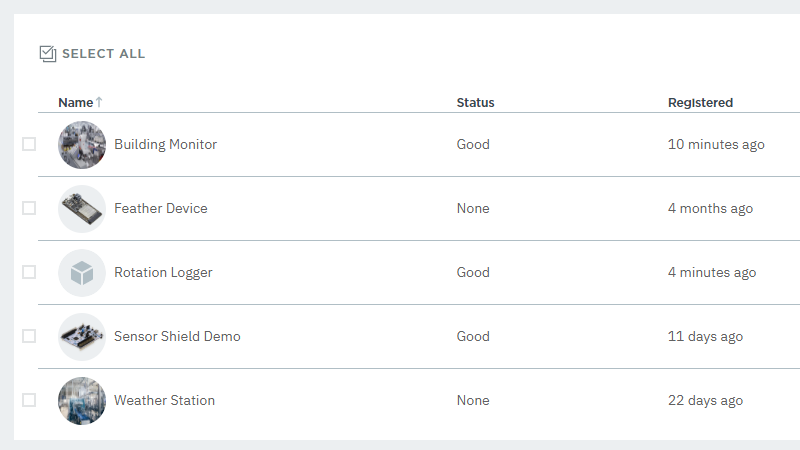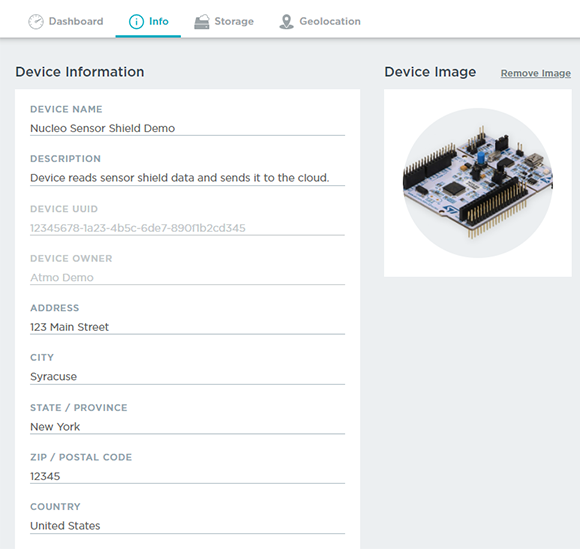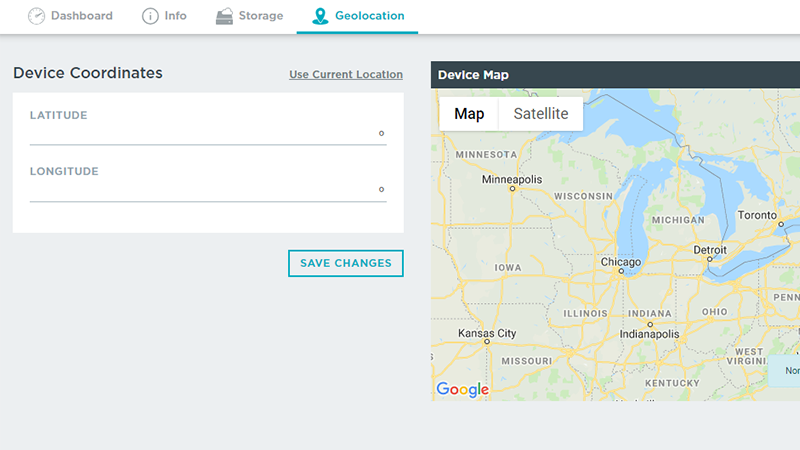Device Console
Atmosphere’s Devices Console is where you can access all of the registered devices within your account.

Devices can be displayed in two formats: grid or table.
Device Consoles
Selecting a device brings you to that device’s console page. A device console includes all potential information and controls for a device, and is divided into the following sections:
| Section | Icon | Description |
|---|---|---|
| Dashboard | Personalized dashboard to display the device’s data and information. | |
| Info | Update the device’s information, profile image, or custom metadata. | |
| Storage | View the device’s data consumption and information. | |
| Geolocation | Update the device’s physical location in the system. | |
| Settings | Update the device’s network settings or deploy an OTA update of its firmware. This section is only available if there are applicable settings that can be changed. |
Device consoles have a global set of options located in the top-right of the screen that are available from any section. These include buttons for viewing its project’s app interface (if the project contains one), and deleting the device.
Viewing the Device App
If an app interface was created in Studio’s Application tab for a device, it’ll be available on that device’s console. As long as the device is powered on and connected to Atmosphere, it can be interacted with. Devices that don’t have an app interface within their Atmosphere project don’t have access to this on their device console.
To display the app, click the button at the top-right of the screen.
If the interface is unable to be displayed, it's because your mobile screen size or browser window is too small to show it. Maximizing your browser window or opening the interface on a larger screen will properly display it.
Device Dashboard
Each registered device has its own unique dashboard, which can be used to display its data. The device’s dashboard is the default section when landing on a device’s console.
Similar to Atmosphere’s Dashboard area, device dashboards allow you to display device data through a variety of widgets. Unlike the main Dashboard however, widgets added on a device dashboard may only be configured for that device.
To add a widget to a dashboard, click the button on the right side of the screen. This displays the menu of available widgets. Selecting a widget then adds it to the dashboard. Once on the dashboard, click the widget’s
button to display its menu. From there you can configure the widget’s settings to your liking.
For information on each of the widgets and how to configure them, visit Configuring the Dashboard.
Device Information
The device’s section contains all of the general information and settings for the device.

From here, you can update its general information, such as its name, description, and other attributes. You can upload an image for the device from this section as well, which will be displayed for the device in any areas of the platform where the device is shown.
Device Storage
This device’s Storage section displays the device’s cloud storage usage, which is the collection of data sent to Atmosphere from the device. Each Developer user receives a total of 20 MB of device storage limit that can be used across up to 5 registered devices.
The device’s storage data is displayed in the Storage Usage area of the screen. You’ll receive a system notification when a device reaches 90% of its storage limit and again when it reaches 100%. If a device reaches its storage limit, it continues storing new data while deleting the oldest data stored in first in, first out order. You can erase a device’s stored data and reset its storage by clicking the Clear Storage Data button.
The Device Data area displays the table of the data consumption across each of the device’s datasets and the percentage each occupies. Within the table you can download (into a CSV spreadsheet) or erase the data for an individual dataset, or can download all data stored for that device by clicking the Download All Data button.
Device Geolocation
The device’s Geolocation section is used to set a physical location for the device, which enables it to be displayed and located on a device map throughout the platform.

A device’s geolocation is marked by its coordinates. There are two methods for setting geolocation:
- Clicking a location on the section’s device map, which sets the latitude and longitude to the map’s coordinates.
- Clicking the Use Current Location button, which sets the latitude and longitude to your physical location. When this button is pressed, you’ll be given a request to share your location. Allow Atmosphere to use your current location to use this method.
When coordinate information is set, click Save Changes to save the device’s geolocation.